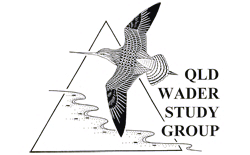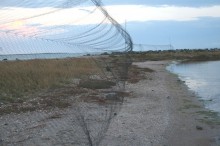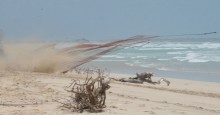Queensland Wader Study Group use two methods to catch waders for banding, mist-netting and cannon netting. The aim is to visit known roost sites on a monthly basis all year round and sample the birds present using one of the following methods
Mist-Netting
Mist nets are fine nets which are stretched between two metal or bamboo poles and tensioned. Birds cannot see the nets easily and flu into them. They then fall into the pocket in the net, behind one of the taught shelf strings where they lie until experienced handlers untangle them and bring them back to a base camp for banding, measuring and weighing. The nets are visited every 20-30 minutes to ensure birds do not remain in the nets for too long.
Shorebirds have exceptionally good eyesight and as a result we do almost all of our mist-netting at night and intercept the birds as they come into high tide roosts. We do occasionally attempt to catch birds at low tide at high density feeding locations but the birds are less concentrated on those locations and our catches are normally very low.
Cannon Netting
The Group also own and use cannon nets which are used to catch larger numbers of birds during daylight. The nets are set and camouflaged at locations where birds are known to congregate. Each net uses 3 or 4 cannons which use a small charge to fire projectiles which carry the net over the top of the birds before they have a chance to fly away.
Once the birds arrive small on foot teams very carefully and slowly walk the birds into the correct location and the net is fired catching the birds.
Our activity schedule is planned each year taking great care to ensure we visit a wide range of sites and don’t disturb any one site too much during the year, ensuring that we balance the conservation value of the data collected against the disturbance each visit inevitably causes.
In addition, every person attending banding is trained in handling and banding birds, and registered with an Animal Ethics committee as a helper on our shorebird monitoring project. The project is also authorised by DERM both regionally and specifically for the Moreton Bay Ramsar site and so our project aims and activities are heavily scrutinised to ensure the data collected is valuable and that our welfare standards continue to remain exceptionally high.
You can access our catch reports by clicking on the links below.


